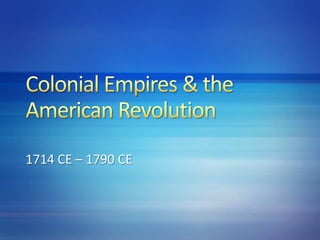
Latin America's Colonial Era and the American Revolution
- 1. 1714 CE – 1790 CE
- 2. In the 16th century, Portugal came to dominate Brazil, while Spain established a colonial empire that included parts of North, Central, and South America This region came to be known as Latin America Latin America was a multi-racial society; Spain allowed intermarriage between Europeans and Native Americas (their offspring were known as mestizos) In addition, as many as 8 million African slaves were brought into Latin America (the offspring of Europeans and Africans were called mulattoes Society was unique in Latin America because of the mixing of ethnicities
- 3. The Portuguese and Spanish both sought profit from their colonies in Latin America There were abundant supplies of gold and silver, which were sent to Europe Farming was also profitable; landowners created immense estates and created a class of dependent peasants by using Native American labor Trade provided another area for profit; products shipped to Europe included sugar, tobacco, diamonds, and animal hides Trade was heavily regulated to prevent the British and French from invading their markets
- 4. Spain and Portugal ruled their colonies for over 300 years; however, because of the vast distance between Europe and Latin America, local colonial officials had considerable freedom in carrying out imperial policies One policy was the “Christianization” of the native population; this gave the Catholic Church a critical role in Latin America and increased the church’s power there Catholic missionaries used missions to help convert, teach, and control the lives of the natives, who were taught to be obedient and docile The Catholic Church built cathedrals, hospitals, orphanages, and schools in the colonies Schools taught the basics of reading, writing, and arithmetic Women could become nuns and enter convents, rather than marry Many nuns ran schools and hospitals and some urged that women be educated
- 5. The United Kingdom of Great Britain came into existence in 1707, when the governments of England and Scotland were united In 18th century Britain, the monarch and the Parliament shared power, with Parliament gradually gaining the upper hand The monarch chose ministers who were responsible to the Crown and set policy and guided Parliament Parliament had the power to make laws, levy taxes, pass the budget, and influence the ministers In 1714, Queen Anne died without an heir; the crown was offered to her nearest relatives, the German Hanoverian kings King George I did not speak English and did not understand the British system very well; his chief ministers handled Parliament Robert Walpole served as the head of cabinet (and later Prime Minister) from 1721 to 1742 and pursued peaceful foreign policy The middle class grew enormously during this time period as a result of trade, and favored policies of expansion of trade and of Britain’s world empire
- 6. William Pitt the Elder became head of the cabinet in 1757; he expanded the British Empire by acquiring Canada and India in the Seven Year’s War In North America, Britain controlled Canada and the 13 colonies on the eastern coast of the Americas By 1750, the British colonies had more than 1 million people and were prosperous The colonies were run by the British Board of Trade, the Royal Council, and Parliament The colonies had their own legislatures that tended to act independently Merchants in the port cities did not want the British government to run their affairs
- 7. After the Seven Year’s War, British leaders wanted to get new revenues from the colonies They were supposed to cover war costs as well as pay the expense of maintaining an army to defend the colonies In 1765 Parliament passed the Stamp Act that required printed materials to carry a stamp showing that a tax had been paid to Britain; Opposition was widespread and violent and the act was repealed in 1766 Crises followed throughout the rest of the 18th century The Colonies organized the First Continental Congress in 1774 Fighting finally erupted in 1775 in Lexington and Concord, Massachusetts The Second Continental Congress met soon after and formed an army with George Washington as its commander in chief On July 4, 1776, the Second Continental Congress approved the Declaration of Independence, marking the official start of the American Revolution
- 8. The Colonists were able to gain foreign support which helped in their fight against the British France provided arms and money, and French officers served in Washington’s army Spain and the Dutch Republic also fought against Great Britain British General Cornwallis was forced to surrender at Yorktown in 1781 The Treaty of Paris was signed in 1783 and recognized the independence of the American colonies
- 9. The 13 colonies gained their independence and were now states in a new union The states feared concentrated power and had little enthusiasm for creating a strong central government, preferring to keep power at the state level The Articles of Confederation were the first attempt at nation-building by the American colonies; they were unsuccessful because the federal government lacked the power to deal with the nation’s problems The US Constitution proposed a federal system in which power would be shared between the federal and state governments The federal government was divided into three branches A Bill of Rights was adopted to ensure individual liberties were maintained by the new government
